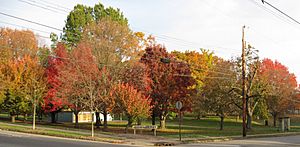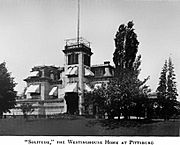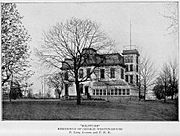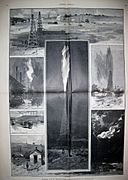Westinghouse Park facts for kids
Westinghouse Park is a public park in Pittsburgh, Pennsylvania. It's about the size of a city block. This park used to be the home of George Westinghouse and his wife, Marguerite. George Westinghouse was a famous American inventor and engineer.
Their home, called Solitude, was on this land. It was about 10 acres big. George Westinghouse worked with other engineers there, like Nikola Tesla. He also hosted important people, such as scientist Lord Kelvin and future president William McKinley.
Close to the main house was a carriage house. In its basement, Westinghouse had a secret lab. He worked on electric lighting there. He even installed a generator and ran wires to his main house. He also invented ways to control and send natural gas to homes and factories.
In 1883, Westinghouse started drilling for natural gas on his property. On May 22, 1884, gas was found! But it shot out of the ground for about a week. Westinghouse then found a way to cap the well. He even lit the gas jet at the top of a tall pipe. It made a 100-foot flame that lit up the area for a mile! This well was called "Westinghouse Well No. 1." Later, tall gas derricks stood over his beautiful gardens. Today, you can't see any signs of these derricks.
Contents
Park History
How the Park Was Created
George Westinghouse passed away in 1914. He left his mansion to his son. In 1918, his son sold the property to the Engineers' Society of Western Pennsylvania. They wanted to create a city park and a memorial for Westinghouse.
The mansion was taken down in 1919, and the park was built. The main Westinghouse Memorial, however, was built a few miles away in Schenley Park.
What You Can Find at the Park Today
Today, the City of Pittsburgh takes care of Westinghouse Park. It has a popular playground for kids. There's also a basketball court and a community building. This building is used for meetings and as a place where people can vote.
You can still see signs of old tunnels. These tunnels once connected the house to the lab and nearby railroad tracks. The park is surrounded by homes in the North Point Breeze neighborhood. On its north side are train tracks and a busway.
Across Thomas Boulevard, to the south, was once the home of H. J. Heinz. He was famous for his food company. His mansion, Greenlawn, is now replaced by smaller houses. You can still see the houses of Westinghouse's son and his doctor nearby. Also close by is the Clayton mansion. It was once the home of another famous industrialist, Henry Clay Frick.
The Park in Books
Writer John Edgar Wideman often wrote about Westinghouse Park in his books. He used the park as a setting in his memoirs, Brothers and Keepers and Hoop Roots. It also appears in his fictional Homewood Trilogy.
Recent Discoveries and Improvements
In 2006, archaeologists explored the park. They found many small items. They also found the exact spot of the old gas well. You can get a great view of the park, including some very old trees, from certain spots.
In 2019, a group called the Westinghouse Park 2nd Century Coalition was formed. They work to make the park better. They also want to share its history and help take care of it for the future.
Gallery
Here are some pictures related to the historic Westinghouse Park site.
- Westinghouse Park 2nd Century Coalition






